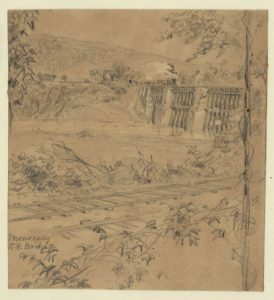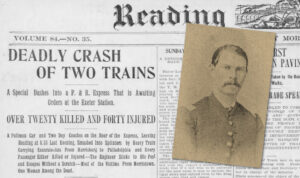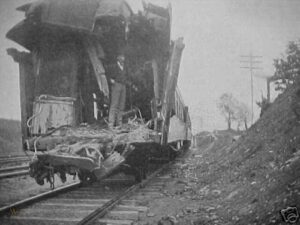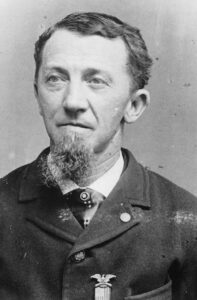First Confederate soldier killed in Maryland?
14 July 2020
While looking for something else, I came upon what may be the story of the first Confederate soldier killed on the Maryland Campaign of 1862. He was one of the earliest, certainly. [Update August 2025: Pvt Alfred Whitaker, 13th North Carolina, was killed in a skirmish on the Potomac on 5 September].
It happened on 8 September 1862, at Monocacy Junction near Frederick, MD, and probably did not involve gunfire.
On that date much of the Army of Northern Virginia (ANV) was in camp in and around Frederick, MD and Private Thomas Riley of the 6th Louisiana Infantry was part of a detail assigned to destroy the nearby railroad bridge across the Monocacy River. They succeeded in blowing it up, but Riley was killed in the process.
About a week later, after the ANV had moved on, the 14th New Jersey Infantry returned to their post at the bridge. In a somewhat gruesome postscript to our story, Sergeant Terrill of the 14th described what they found:
Everything looked desolate. The bridge destroyed, remnants of wagons, dead horses and mules lying around… It was raining hard and very muddy. Tents were pitched in a plowed field in regular order, guards were stationed around camp …
The rebels [had] left a squad of men to destroy the bridge; in the attempt one man was blown up and buried near the ruins, leaving his arms and head above ground. This was the first rebel the men had ever seen, and for some time was an object of curiosity to us; he lay exposed several days; at last his remains were taken up and decently interred by our men.
________
The picture at the top is a sketch by Alfred Waud of the railroad bridge as it looked in June or July 1863, after it had been rebuilt. The original is in the Library of Congress.
Lieutenant Anthony Morin
4 April 2020
James Grant of the Christian Commission was on the field after the battle of Antietam …
While moving around amongst the wounded … my attention was called by a disabled officer to a friend of his, badly wounded in the face, and lying out somewhere without a covering. Following his directions, and throwing the rays of my lantern towards the foot of a wooden fence, I soon discovered the object of my search … The ball had entered one side of the cheek and passed out at the other, grazing his tongue, and carrying away several of his teeth. His face was horribly swollen, and he could not speak. On asking him if he was Lieut. M. [Morin], of Philadelphia, he assented by a nod of his head.
During the next two days, the Surgeons were all so busy, that his wound, which had been hurriedly dressed on the field, remained untouched; yet he showed no signs of impatience. In the inflamed, wounded condition of his mouth, nothing could be passed down his throat. On the third day, as the Surgeons still had more to do than they could manage … [w]ith some hesitation, I took the Lieutenant’s case in hand, and, after two hours’ labor, succeeded in cutting away his whiskers and washing the wound pretty thoroughly, both inside and outside the mouth. This done, and all the clotted blood and matter cleared away, the swelling abated, and he began to articulate a little. A day or so afterward, he could swallow liquids; and being carefully washed daily, in less than a week he was able to travel to Philadelphia …
__________________
Notes
This excellent photograph of First Lieutenant Anthony Morin of Company D, 90th Pennsylvania Infantry is from the collection of Scott Hann.
The quotes here from Edward P. Smith’s Incidents among Shot and Shell (1868), online from the Hathi Trust.
Deadly crash of two trains
23 March 2020
Corporal John H “Highly” Coulston, Company A, 51st Pennsylvania Infantry was wounded at Fox’s Gap on South Mountain in September 1862. He was Captain by January 1865 and mustered out in July.
Tragically, he was severely injured in a train crash – known afterwards as the Exeter Station wreck – on 12 May 1899 while returning with many other veterans from the dedication of a statue of statue of General Hartranft in Harrisburg. He died the next day.
Superimposed on the front page of the Reading Times of 13 May 1899 above is a picture of him c. 1864 from a published photograph contributed to his Findagrave memorial by Charles McDonald.
The crushed train car below testifies to the force of the collision. Below that is a post-war photograph of Isaac E Filman – also of Company A and wounded at Fox’s Gap, and also killed in the crash (lower two photos from the Pottstown Mercury of 1 July 2012).





